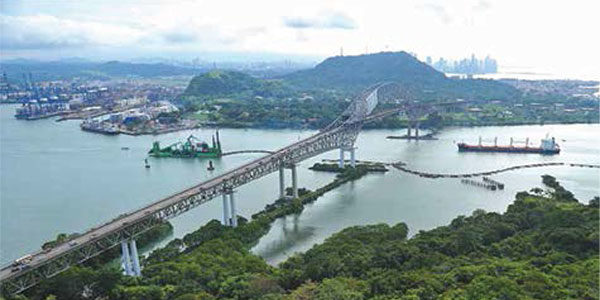"Digging" the expanded Panama Canal's potential: interview with John W. Wallace Jr.

Advocates of Panamanian trade and business interests won't have much idle time over the next year or two. The opening of the expanded Panama Canal, now slated for April 2015 after weather and construction delays pushed it beyond its original October 2014 launch date, will be a watershed event for intercontinental trade. The expanded canal, which will accommodate ships nearly three times the size of what sails through today, carries with it a nation's dreams of becoming to its region what Singapore and Dubai became to theirs: a dominant hub of production, distribution, and trans-shipping.
John W. Wallace Jr. is at the forefront of the U.S. advocacy efforts. The Atlanta-based Wallace, who has spent most of his career in the financial services industry, is the founder and chairman of the Panama Gateway International Association Inc., a national organization tasked with marketing Panama's budding logistics network and the commercial opportunities that flow from it. Wallace's objective is to differentiate Panama from other countries in the region in what is shaping up to be a hotly competitive fight for the hearts, minds, and wallets of global producers and distributors interested in setting up shop in Latin America.
Wallace recently spoke with Senior Editor Mark B. Solomon about his mission that, if successful, will give Panama a "seat at the table to compete for business anywhere in the U.S."
 Q: How relevant is the Panama Canal to U.S. commerce?
Q: How relevant is the Panama Canal to U.S. commerce?
A: It is our understanding that 15 percent of all U.S. trade passes through the canal each year. About 70 percent of all cargo and 56 percent of all vessels transiting the canal have a U.S. origin or destination.
Q: How did your group get started, and what is its objective?
A: We were created in 2008 as a nonprofit entity to connect the Hemiäpheres. Our main objective is to educate private enterprises and public institutions in awareness, marketing, and promotional positioning, and to facilitate emerging business opportunities between the United States and Panama and how they relate to the rest of Latin America.
We launched as the United States Panama Business Council, Southeast, Inc. with a focus on the Southeast region of the U.S. In 2012, we changed our name to the Panama Gateway International Association Inc. to expand the group's mission to be the "go-to" business education forum. We are headquartered in Atlanta, and our board members are spread out across the country.
We are involved in the U.S. National Export Initiative, the Advisory Committee on Supply Chain Competitiveness, and the U.S.-Panama Trade Promotion Agreement. Our work also involves the expansion of the canal and Panama's goal of becoming Latin America's most visible product distribution hub.
We also act as a liaison between industry and government, which is an important step toward ensuring regular contact with manufacturers, distributors, and exporters.
Q: Much of the discussion in the U.S. has centered on how the canal may alter shipping and distribution patterns as mega-ships will be able to sail directly to the East Coast instead of docking at Los Angeles/Long Beach. Do you think that's an overstated case?
A: The new canal has forced all importers, exporters, logistics centers, shippers, distributors, and manufacturers to evaluate their current condition and consider options for improved efficiency going forward.
Q: What have you heard from U.S. importers as it relates to their changing their distribution networks once the canal is operational?
A: The good news is that importers and exporters are in expansion mode and we would like to think this is amplified by the expansion of the canal.
Q: Do you think U.S. interests have been too U.S.-centric in the debate over the canal and have lost sight of what the canal is ultimately designed to do for Panama?
A: U.S. interest is equal to every other country's interest in determining how the expansion will impact their economic growth. It boils down to competitive positioning to reach new global markets. The U.S. and Panama have gone to great lengths to cooperate, as evidenced by a comprehensive bilateral free trade agreement signed in 2011. The agreement should significantly liberalize trade in goods and services. A secondary benefit is commercial opportunities with other countries that already have free trade agreements with the United States.
Q: What is the view among Panamanian officials of the canal's value to the country and to the world?
A: The main purpose of the canal expansion program is to increase Panama's ability to benefit from growing traffic demand. This growing demand is manifested both in cargo volume increases as well as in an increase in the size of vessels that will use the Panama route. Our role is to expand on the existing memoranda of understanding between the Panama Canal Authority and U.S. ports to expand export/import opportunities through the knowledge of each other's capabilities.
Q: What advice would you give U.S. business interests as they weigh whether the canal reshapes trade and transport flows on multiple continents?
A: The expanded canal will and already has reshaped trade and transit flows. The question is how do companies adjust to the new reality. Part of that answer is having a broad knowledge base of the opportunities and a deep network of specialists through which to ask strategic questions.
Related Articles

Copyright ©2024. All Rights ReservedDesign, CMS, Hosting & Web Development :: ePublishing